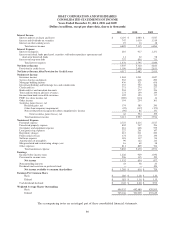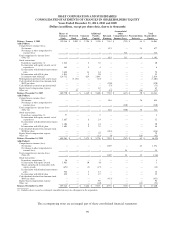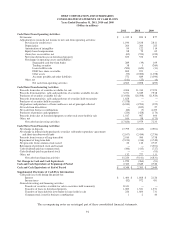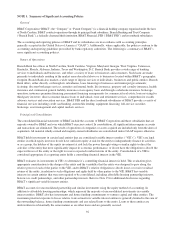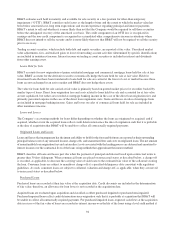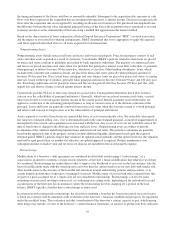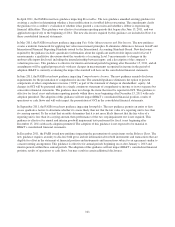BB&T 2011 Annual Report Download - page 96
Download and view the complete annual report
Please find page 96 of the 2011 BB&T annual report below. You can navigate through the pages in the report by either clicking on the pages listed below, or by using the keyword search tool below to find specific information within the annual report.to pay all debt obligations, and an evaluation of secondary sources of payment from the client and any guarantors. This
evaluation also includes an evaluation of the borrower’s current willingness to pay, which may include a review of past
payment history, an evaluation of the borrower’s willingness to provide information on a timely basis, and consideration
of offers from the borrower to provide additional collateral or guarantor support. The credit evaluation also reflects
consideration of the borrower’s future capacity and willingness to pay, which may include evaluation of cash flow
projections, consideration of the adequacy of collateral to cover all principal and interest and trends indicating improving
profitability and collectability of receivables.
The evaluation of mortgage and consumer loans includes an evaluation of the client’s debt to income ratio, credit report,
property value, loan vintage, and certain other client-specific factors that have impacted their ability to make timely
principal and interest payments on the loan.
Restructured nonaccrual loans may be returned to accrual status based on a current, well-documented credit evaluation of
the borrower’s financial condition and prospects for repayment under the modified terms. This evaluation must include
consideration of the borrower’s sustained historical repayment performance for a reasonable period (generally a minimum
of six months) prior to the date on which the loan is returned to accrual status. Sustained historical repayment
performance for a reasonable time prior to the restructuring may be taken into account. In connection with retail
restructurings, a nonperforming loan will be returned to accruing status when current as to principal and interest and upon
a sustained historical repayment performance (generally a minimum of six months).
Allowance for Credit Losses
The allowance for credit losses comprises the allowance for loan and lease losses and the reserve for unfunded lending
commitments. The allowance for credit losses represents management’s best estimate of probable credit losses inherent in
the loan and lease portfolios and off-balance sheet lending commitments at the balance sheet date. The Company
determines the allowance for credit losses based on an ongoing evaluation. This evaluation is inherently subjective
because it requires material estimates, including the amounts and timing of cash flows expected to be received on
impaired loans. Those estimates are susceptible to significant change. Changes to the allowance for credit losses are made
by charges to the provision for credit losses, which is reflected in the Consolidated Statements of Income. Loans or lease
balances deemed to be uncollectible are charged off against the allowance for loan and lease losses. Recoveries of
amounts previously charged off are credited to the allowance for loan and lease losses. The methodology used to
determine the reserve for unfunded lending commitments is inherently similar to that used to determine the collective
component of the allowance for loan and lease losses described above, adjusted for factors specific to binding
commitments, including the probability of funding and exposure at default. While management uses the best information
available to establish the allowance for credit losses, future adjustments may be necessary if economic conditions differ
substantially from the assumptions used in computing the allowance or, if required by regulators, based upon information
available to them at the time of their examinations.
Accounting standards require the presentation of certain disclosure information at the portfolio segment level, which
represents the level at which an entity develops and documents a systematic methodology to determine its allowance for
credit losses. BB&T concluded that its loan and lease portfolio comprises three portfolio segments; commercial, retail and
covered and other acquired. The commercial portfolio segment includes commercial real estate, commercial and industrial
and other loans originated by certain other lending subsidiaries, and was identified based on the risk-based approach used
to estimate the allowance for loan and lease losses for the vast majority of these loans. The retail portfolio segment
includes direct retail lending, revolving credit, mortgage, sales finance and other loans originated by certain retail-oriented
subsidiaries, and was identified based on the delinquency-based approach used to estimate the allowance for these loans.
The covered and other acquired portfolio segment was identified based on the expected cash flows approach used to
estimate the allowance related to loans acquired subsequent to December 31, 2008.
A portion of the Corporation’s allowance for loan and lease losses is not allocated to any specific category of loans. This
unallocated portion of the allowance reflects management’s best estimate of the elements of imprecision and estimation
risk inherent in the calculation of the overall allowance. Due to the subjectivity involved in determining the overall
allowance, including the unallocated portion, the portion considered unallocated may fluctuate from period to period
based on management’s evaluation of the factors affecting the assumptions used in calculating the allowance, including
historical loss experience, current economic conditions, industry or borrower concentrations and the status of merged
institutions.
96





